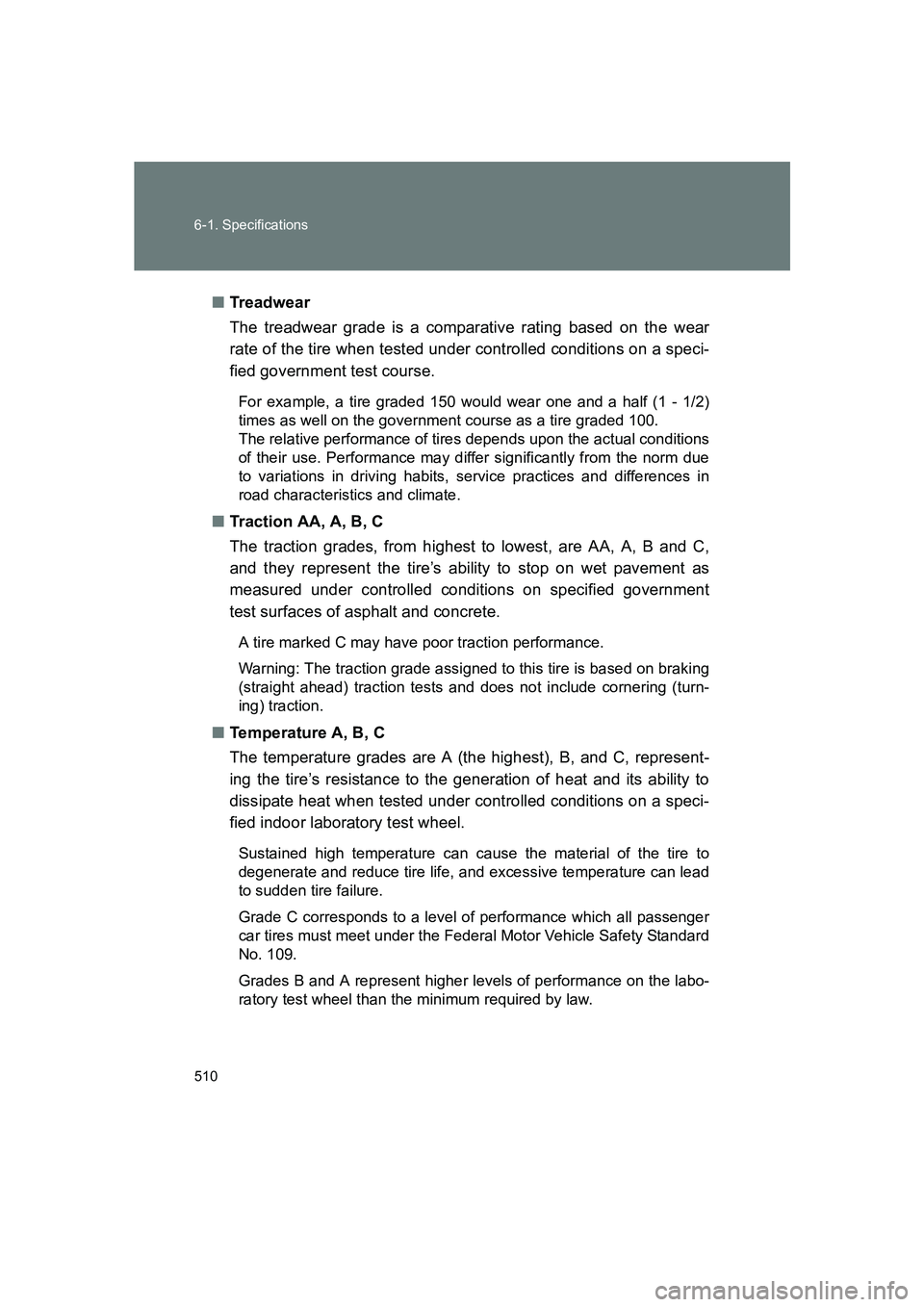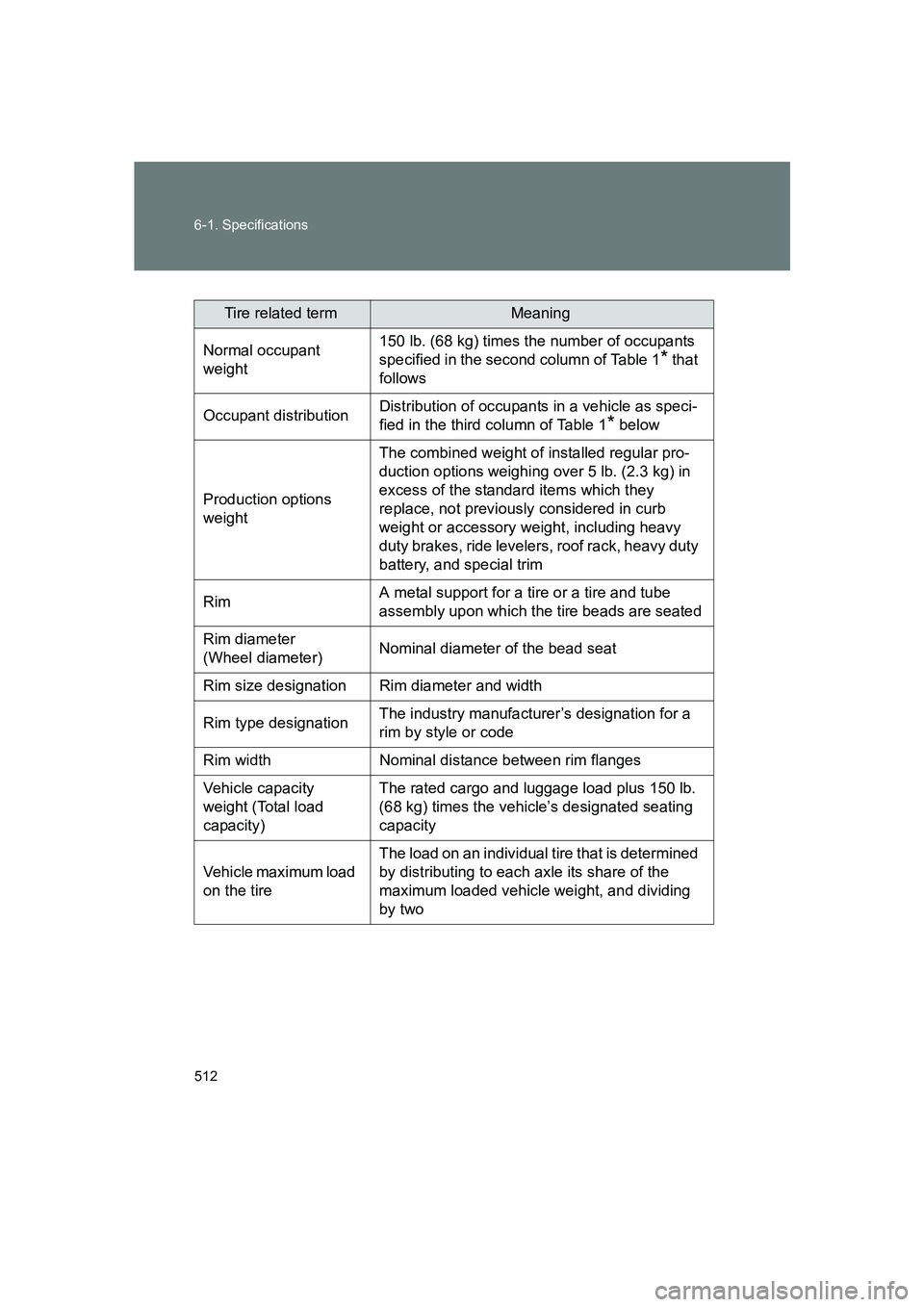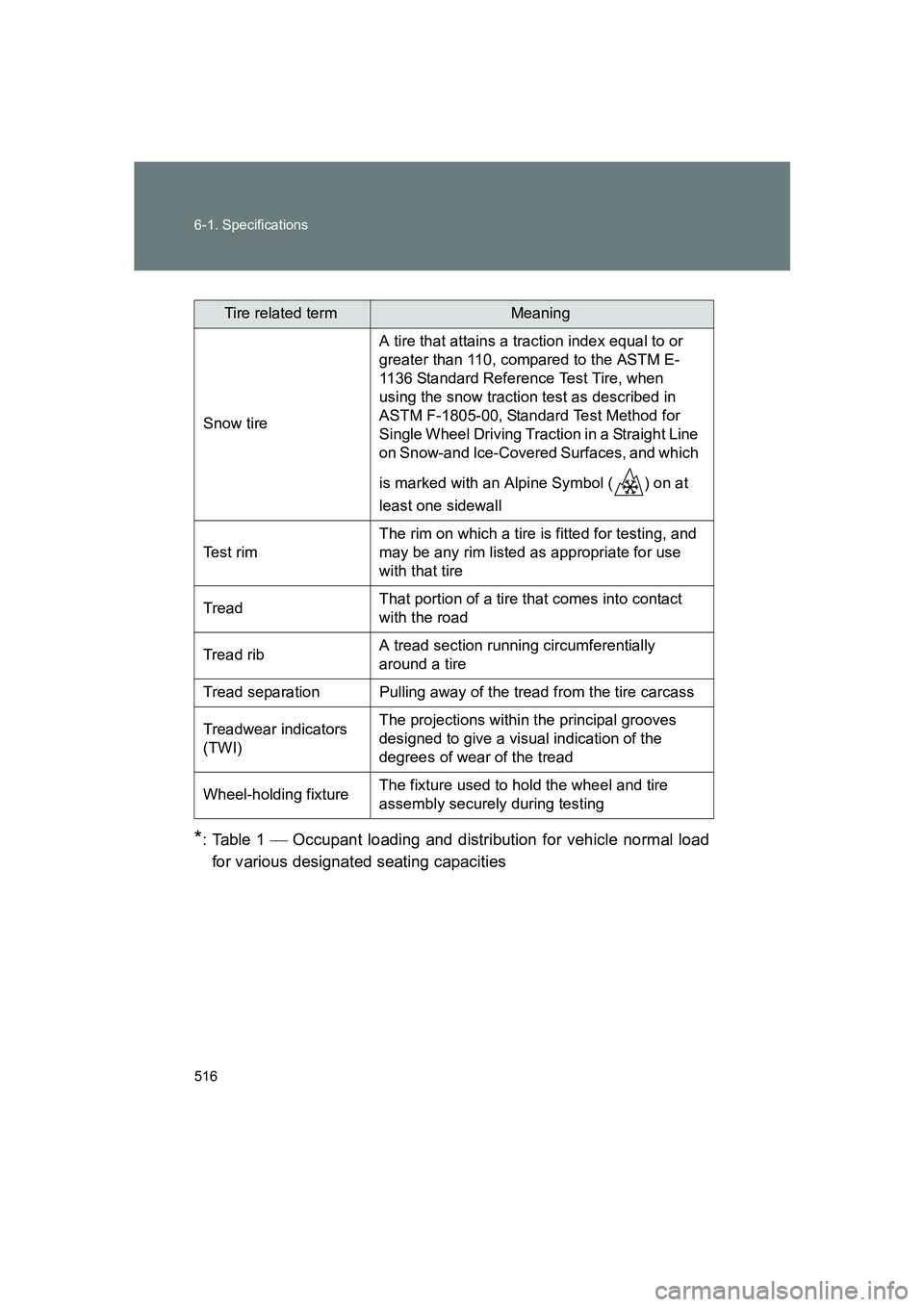Page 488 of 560
488
BRZ_U
6-1. Specifications
Maintenance data (fuel, oil level, etc.)
Dimensions and weight
*: Unladen vehicle
Overall length 166.7 in. (4235 mm)
Overall width 69.9 in. (1775 mm)
Overall height*52.0 in. (1320 mm)
Wheelbase 101.2 in. (2570 mm)
TreadFront 59.8 in. (1520 mm)
Rear 60.6 in. (1540 mm)
Vehicle capacity weight
(Occupants + luggage)Details are described on the tire and load-
ing information label. (
→P. 378)
Page 498 of 560
498 6-1. Specifications
BRZ_U■
Brake disc
If you need information on the usage limit value of brake discs and
the method for measuring them, we recommend that you consult
your SUBARU dealer.
Steering
Tires and wheels (for vehicles sold in the U.S.A. and Canada)
Ty p e A
Ty p e B
Free play Less than 1.2 in. (30 mm)
Tire size 215/45R17 87W, T135/80D16 101M
Tire inflation pressure
(Recommended cold tire
inflation pressure) Front
35 psi (240 kPa, 2.4 kgf/cm2 or bar)
Rear 35 psi (240 kPa, 2.4 kgf/cm
2 or bar)
Spare 60 psi (420 kPa, 4.2 kgf/cm
2 or bar)
Wheel size 17 × 7 J, 16 × 4T (spare)
Wheel nut torque 89 ft•lbf (120 N•m, 12.2 kgf•m)
Tire size 215/45R17 87W, T145/70D17 106M
Tire inflation pressure
(Recommended cold tire
inflation pressure)Front
35 psi (240 kPa, 2.4 kgf/cm
2 or bar)
Rear 35 psi (240 kPa, 2.4 kgf/cm
2 or bar)
Spare 60 psi (420 kPa, 4.2 kgf/cm
2 or bar)
Wheel size 17 × 7 1/2 J, 17 × 4T (spare)
Wheel nut torque 89 ft•lbf (120 N•m, 12.2 kgf•m)
Page 499 of 560
499
6-1. Specifications
6
Vehicle specifications
BRZ_U
Ty p e C
Tires and wheels (for vehicles sold in Mexico)
Tire size 215/40R18 85Y, T145/70D17 106M
Tire inflation pressure
(Recommended cold tire
inflation pressure)
Front
35 psi (240 kPa, 2.4 kgf/cm2 or bar)
Rear 35 psi (240 kPa, 2.4 kgf/cm
2 or bar)
Spa re 60 psi (420 kPa, 4.2 kgf/cm
2 or bar)
Wheel size 18 × 7 1/2 J, 17 × 4T (spare)
Wheel nut torque 89 ft•lbf (120 N•m, 12.2 kgf•m)
Tire size 215/45R17 87W
Tire inflation pressure
(Recommended cold tire
inflation pressure) Front
35 psi (240 kPa, 2.4 kgf/cm
2 or bar)
Rear 35 psi (240 kPa, 2.4 kgf/cm
2 or bar)
Spa re 35 psi (240 kPa, 2.4 kgf/cm
2 or bar)
Wheel size 17 × 7 J
Wheel nut torque 89 ft•lbf (120 N•m, 12.2 kgf•m)
Page 508 of 560
508 6-1. Specifications
BRZ_U
Tire size■ Typical tire size information
The illustration indicates typical
tire size.
Tire use
(P = Passenger car,
T = Temporary use)
Section width (millimeters)
Aspect ratio
(tire height to section width)
Tire construction code
(R = Radial, D = Diagonal)
Wheel diameter (inches)
Load index (2 or 3 digits)
Speed symbol
(alphabet with one letter)
■ Tire dimensions
Section width
Tire height
Wheel diameter
Page 510 of 560

510 6-1. Specifications
BRZ_U■
Tre ad w ea r
The treadwear grade is a comparative rating based on the wear
rate of the tire when tested under controlled conditions on a speci-
fied government test course.
For example, a tire graded 150 would wear one and a half (1 - 1/2)
times as well on the government course as a tire graded 100.
The relative performance of tires depends upon the actual conditions
of their use. Performance may differ significantly from the norm due
to variations in driving habits, service practices and differences in
road characteristics and climate.
■Traction AA, A, B, C
The traction grades, from highest to lowest, are AA, A, B and C,
and they represent the tire’s ability to stop on wet pavement as
measured under controlled conditions on specified government
test surfaces of asphalt and concrete.
A tire marked C may have poor traction performance.
Warning: The traction grade assigned to this tire is based on braking
(straight ahead) traction tests and does not include cornering (turn-
ing) traction.
■Temperature A, B, C
The temperature grades are A (the highest), B, and C, represent-
ing the tire’s resistance to the generation of heat and its ability to
dissipate heat when tested under controlled conditions on a speci-
fied indoor laboratory test wheel.
Sustained high temperature can cause the material of the tire to
degenerate and reduce tire life, and excessive temperature can lead
to sudden tire failure.
Grade C corresponds to a level of performance which all passenger
car tires must meet under the Federal Motor Vehicle Safety Standard
No. 109.
Grades B and A represent higher levels of performance on the labo-
ratory test wheel than the minimum required by law.
Page 512 of 560

512 6-1. Specifications
BRZ_U
Tire related termMeaning
Normal occupant
weight 150 lb. (68 kg) times the number of occupants
specified in the second column of Table 1
* that
follows
Occupant distribution Distribution of occupants in a vehicle as speci-
fied in the third column of Table 1
* below
Production options
weight The combined weight of installed regular pro-
duction options weighing over 5 lb. (2.3 kg) in
excess of the standard items which they
replace, not previously considered in curb
weight or accessory weight, including heavy
duty brakes, ride levelers, roof rack, heavy duty
battery, and special trim
Rim A metal support for a tire or a tire and tube
assembly upon which the tire beads are seated
Rim diameter
(Wheel diameter) Nominal diameter of the bead seat
Rim size designation Rim diameter and width
Rim type designation The industry manufacturer’s designation for a
rim by style or code
Rim width Nominal distance between rim flanges
Vehicle capacity
weight (Total load
capacity) The rated cargo and luggage load plus 150 lb.
(68 kg) times the vehicle’s designated seating
capacity
Vehicle maximum load
on the tire The load on an individual tire that is determined
by distributing to each axle its share of the
maximum loaded vehicle weight, and dividing
by two
Page 515 of 560

515
6-1. Specifications
6
Vehicle specifications
BRZ_U
Tire related termMeaning
Overall width The linear distance between the exteriors of
the sidewalls of an inflated tire, including eleva-
tions due to labeling, decorations, or protective
bands or ribs
Passenger car tire A tire intended for use on passenger cars, mul-
tipurpose passenger vehicles, and trucks, that
have a gross vehicle weight rating (GVWR) of
10,000 lb. or less.
Ply A layer of rubber-coated parallel cords
Ply separation A parting of rubber compound between adja-
cent plies
Pneumatic tire A mechanical device made of rubber, chemi-
cals, fabric and steel or other materials, that,
when mounted on an automotive wheel, pro-
vides the traction and contains the gas or fluid
that sustains the load
Radial ply tire A pneumatic tire in which the ply cords that
extend to the beads are laid at substantially 90
degrees to the centerline of the tread
Reinforced tire A tire designed to operate at higher loads and
at higher inflation pressures than the corre-
sponding standard tire
Section width The linear distance between the exteriors of
the sidewalls of an inflated tire, excluding ele-
vations due to labeling, decoration, or protec-
tive bands
Sidewall That portion of a tire between the tread and
bead
Sidewall separation The parting of the rubber compound from the
cord material in the sidewall
Page 516 of 560

516 6-1. Specifications
BRZ_U
*:Table 1 Occupant loading and distribution for vehicle normal load
for various designated seating capacities
Tire related termMeaning
Snow tire A tire that attains a traction index equal to or
greater than 110, compared to the ASTM E-
1136 Standard Reference Test Tire, when
using the snow traction test as described in
ASTM F-1805-00, Standard Test Method for
Single Wheel Driving Traction in a Straight Line
on Snow-and Ice-Covered Surfaces, and which
is marked with an Alpine Symbol ( ) on at
least one sidewall
Te s t r i m The rim on which a tire is fitted for testing, and
may be any rim listed as appropriate for use
with that tire
Trea d That portion of a tire that comes into contact
with the road
Tread rib A tread section running circumferentially
around a tire
Tread separation Pulling away of the tread from the tire carcass
Treadwear indicators
(TWI) The projections within the principal grooves
designed to give a visual indication of the
degrees of wear of the tread
Wheel-holding fixture The fixture used to hold the wheel and tire
assembly securely during testing